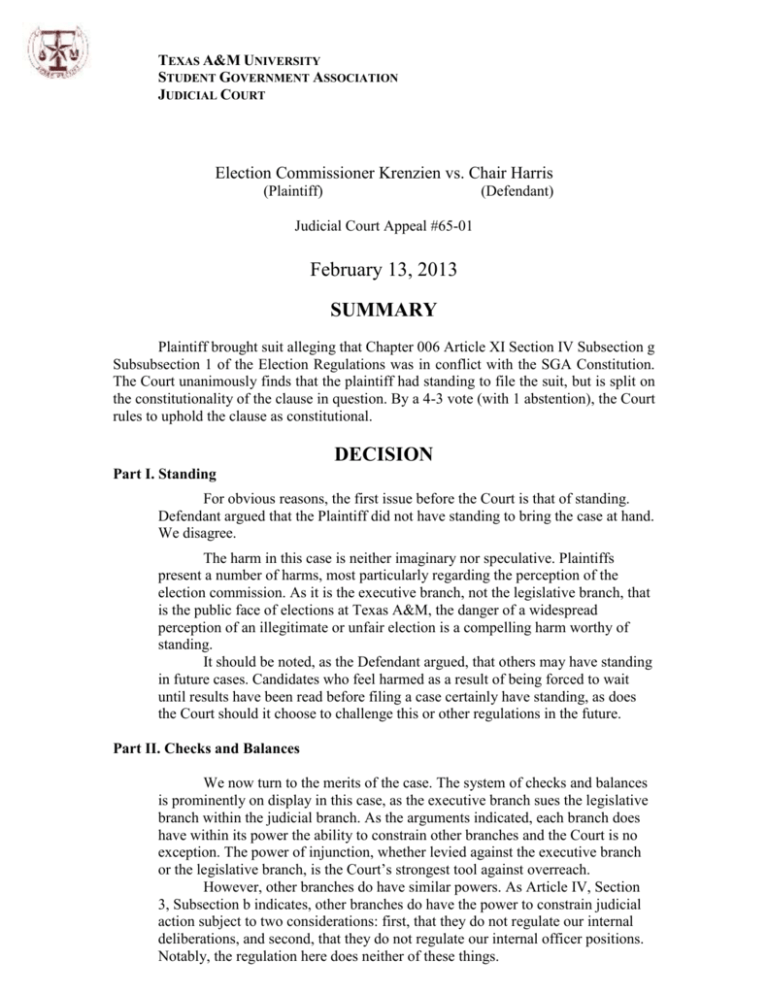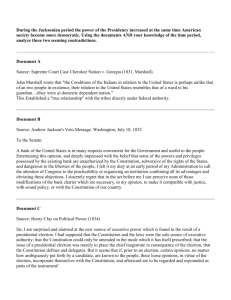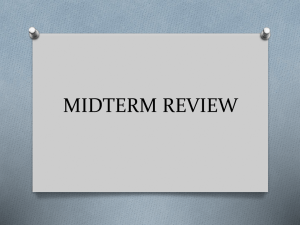SGA Judicial Court - Texas A&M University
advertisement

TEXAS A&M UNIVERSITY STUDENT GOVERNMENT ASSOCIATION JUDICIAL COURT Election Commissioner Krenzien vs. Chair Harris (Plaintiff) (Defendant) Judicial Court Appeal #65-01 February 13, 2013 SUMMARY Plaintiff brought suit alleging that Chapter 006 Article XI Section IV Subsection g Subsubsection 1 of the Election Regulations was in conflict with the SGA Constitution. The Court unanimously finds that the plaintiff had standing to file the suit, but is split on the constitutionality of the clause in question. By a 4-3 vote (with 1 abstention), the Court rules to uphold the clause as constitutional. DECISION Part I. Standing For obvious reasons, the first issue before the Court is that of standing. Defendant argued that the Plaintiff did not have standing to bring the case at hand. We disagree. The harm in this case is neither imaginary nor speculative. Plaintiffs present a number of harms, most particularly regarding the perception of the election commission. As it is the executive branch, not the legislative branch, that is the public face of elections at Texas A&M, the danger of a widespread perception of an illegitimate or unfair election is a compelling harm worthy of standing. It should be noted, as the Defendant argued, that others may have standing in future cases. Candidates who feel harmed as a result of being forced to wait until results have been read before filing a case certainly have standing, as does the Court should it choose to challenge this or other regulations in the future. Part II. Checks and Balances We now turn to the merits of the case. The system of checks and balances is prominently on display in this case, as the executive branch sues the legislative branch within the judicial branch. As the arguments indicated, each branch does have within its power the ability to constrain other branches and the Court is no exception. The power of injunction, whether levied against the executive branch or the legislative branch, is the Court’s strongest tool against overreach. However, other branches do have similar powers. As Article IV, Section 3, Subsection b indicates, other branches do have the power to constrain judicial action subject to two considerations: first, that they do not regulate our internal deliberations, and second, that they do not regulate our internal officer positions. Notably, the regulation here does neither of these things. Although the connection between our internal deliberations and our ability to hold hearings is a close one, the Constitution makes it clear that they are not one and the same. In the same citation, the Constitution draws a line between the “internal deliberations” and the “hearings”, creating a clear temporal distance between the two. While this distinction seems petty from an ontological perspective, it does plainly exist and we must rule as so. The power of the Senate to impose restrictions like the one in question does exist. However, it is subject to the same constraints every other action must meet: specifically, it must be in line with the Constitution. As the Judicial Court, it is our prerogative, and our prerogative alone, to determine whether or not this and any other actions do conflict with constitutional protections. The Student Senate and Executive Branch may certainly seek to enact constraints on the Court, but all such constraints must be judged against the Constitution, a role that the Court alone serves. Thus, we serve the unique role of having the power to assent to any constraints upon our branch. The Court does, in general, owe deference to actions by other branches as long as those actions can be reasonably supported by the Constitution. If no reasonable interpretation of the Constitution supports the action in question it is undoubtedly unconstitutional. As above, this question is exclusively answered by the Court. In this case, a majority of the Court finds that a reasonable interpretation of the Constitution authorizes this constraint. Although the right to a “speedy and public trial” is a powerful argument (in fact, an argument which swayed the dissent), a majority of the justices voting felt that this provision could reasonably be interpreted in harmony with this provision. This provision does not deny candidates access to the Court: instead, it merely asks that they wait a maximum of one week before doing so. Although this may have negative repercussions on the election process (see below), it is not unreasonable to hold 1-1.5 weeks to satisfy the “speedy and public trial” requirement. Because a reasonable interpretation exists to support this regulation, the Court does show deference. Importantly, “reasonable” is in the eye of the beholder (as the dissent indicates). Policies prohibiting the Court from ever meeting could never find reasonable support in the Constitution but no clear bright-line exists. If other constraints (or even this one in another session) are challenged in the future, the Court may again view the provision with skeptical deference. Part III. Policy Implications Despite the ruling of constitutionality, the Court does have serious reservations about the wisdom of the policy. As the presence of the three-person dissent makes clear, this policy verges on unconstitutionality. While policymaking is the domain of the Student Senate, this case highlights a number of apparently unanticipated dangers associated with this provision. The Court would urge the Senate to reevaluate this provision, especially in consultation with the Election Commission. This election season should be instructive as to strengths and weaknesses. The Court also has reservations about the Senate’s decision to constrain our actions. Although a majority of justices feel that a reasonable interpretation of the Constitution can support this provision, the same effect (or, likely, a better one) could have been achieved through collaboration of the Senate, the Court, and the Election Commission. Each of these groups has an interest in a successful election, so the use of unilateral action is unnecessary and unwise. The Court would urge the Senate to 1) more thoroughly consider collaborative actions rather than unilateral actions and 2) work with the Judicial Court to clarify what constraints can and cannot be placed upon our activities. …It is so ORDERED









